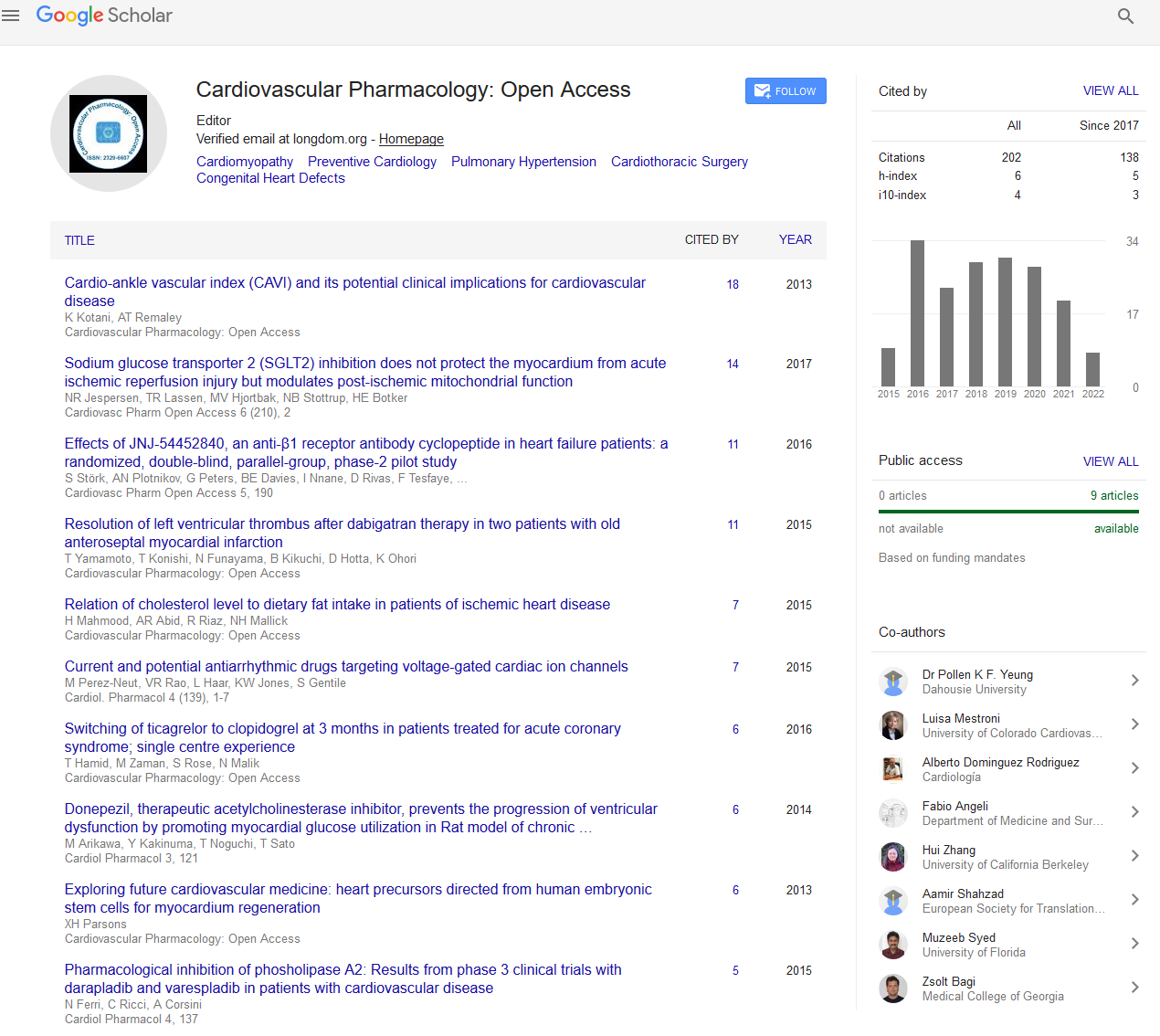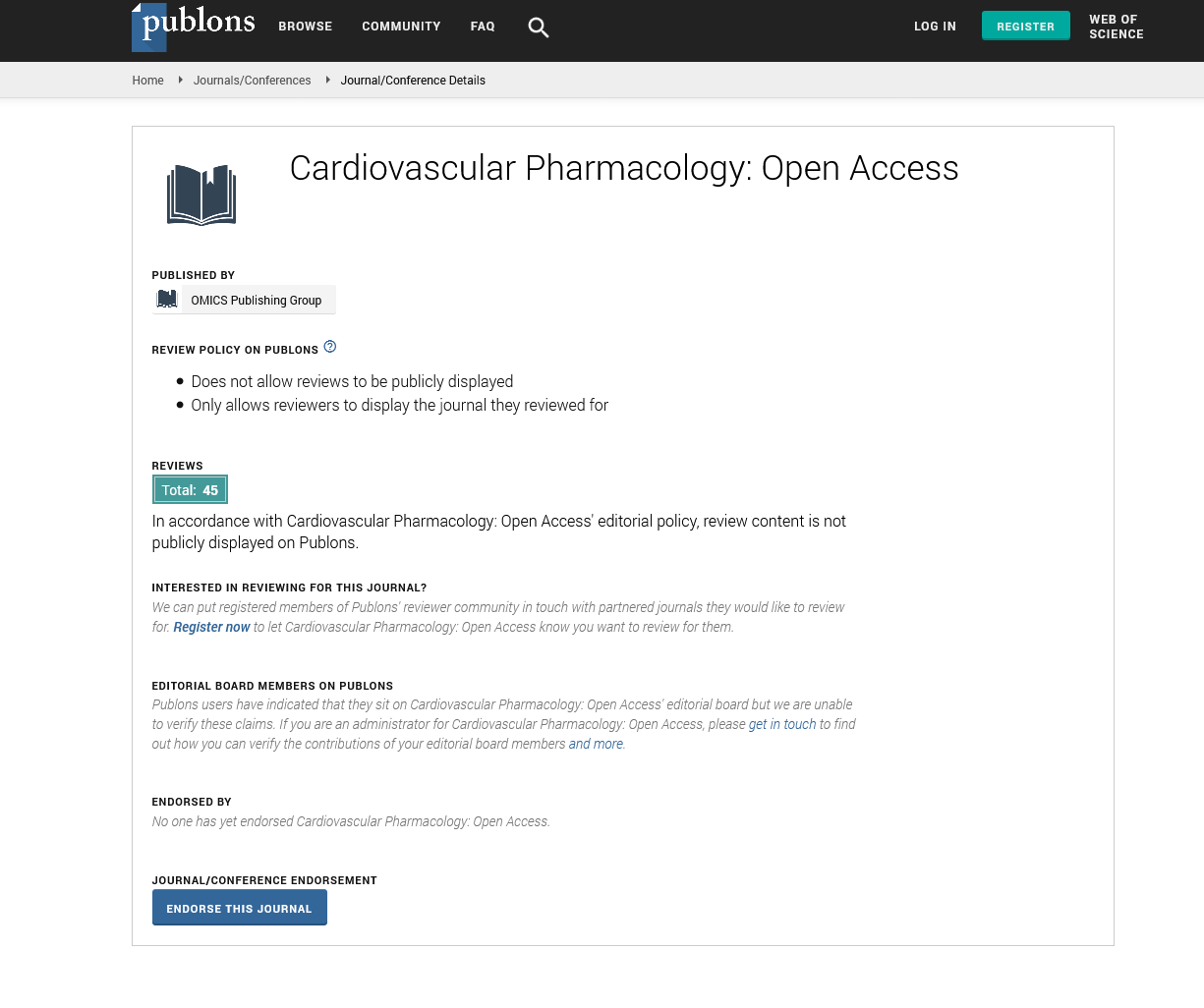Indexed In
- Open J Gate
- Cosmos IF
- RefSeek
- Hamdard University
- EBSCO A-Z
- OCLC- WorldCat
- Publons
- Geneva Foundation for Medical Education and Research
- Euro Pub
- Google Scholar
Useful Links
Share This Page
Journal Flyer

Open Access Journals
- Agri and Aquaculture
- Biochemistry
- Bioinformatics & Systems Biology
- Business & Management
- Chemistry
- Clinical Sciences
- Engineering
- Food & Nutrition
- General Science
- Genetics & Molecular Biology
- Immunology & Microbiology
- Medical Sciences
- Neuroscience & Psychology
- Nursing & Health Care
- Pharmaceutical Sciences
Opinion - (2025) Volume 14, Issue 2
Pharmacological Management of Heart Failure with Reduced Ejection Fraction
Anna Schmidt*Received: 29-May-2025, Manuscript No. CPO-25-29833; Editor assigned: 31-May-2025, Pre QC No. CPO-25-29833; Reviewed: 14-Jun-2025, QC No. CPO-25-29833; Revised: 20-Jun-2025, Manuscript No. CPO-25-29833; Published: 28-Jun-2025, DOI: 10.35248/2329-6607.25.14.429
Description
Heart Failure with reduced Ejection Fraction (HFrEF) is characterized by the heart’s diminished ability to contract effectively leading to inadequate perfusion of tissues. This results in symptoms such as fatigue, shortness of breath and fluid retention. Over recent decades’ pharmacological interventions have profoundly improved both survival and quality of life for patients living with this condition. The core of therapy focuses on interrupting maladaptive neurohormonal activation pathways that contribute to disease progression. Agents such as Angiotensin-Converting Enzyme (ACE) inhibitors, Angiotensin Receptor Blockers (ARBs), beta blockers and Mineralocorticoid Receptor Antagonists (MRAs) form the foundation of treatment. Together these medications reduce afterload control excessive neurohormonal stimulation and prevent remodeling of the myocardium which is crucial in slowing disease progression.
Beta blockers are especially valuable in HFrEF management due to their ability to reduce mortality and hospitalizations. These drugs counteract sympathetic nervous system over activity which is a hallmark of heart failure. By lowering heart rate, decreasing myocardial oxygen consumption and improving ventricular filling beta blockers help the heart function more efficiently. Commonly prescribed beta blockers in HFrEF include carvedilol metoprolol succinate and bisoprolol, all of which have demonstrated significant survival benefits in large randomized clinical trials. The greatest therapeutic effect is achieved when beta blockers are introduced gradually and titrated carefully to the maximum tolerated dose. This slow titration helps minimize adverse effects such as bradycardia and worsening heart failure symptoms during initiation.
A major advancement in recent years has been the introduction of Angiotensin Receptor-Neprilysin Inhibitors (ARNIs) which have shifted the treatment paradigm. Sacubitril/valsartan combines traditional blockade of angiotensin II receptors with neprilysin inhibition. Neprilysin is an enzyme responsible for degrading natriuretic peptides which have beneficial effects such as vasodilation natriuretic and inhibition of fibrosis. By enhancing the activity of natriuretic peptides while blocking the harmful effects of angiotensin II sacubitril/valsartan produces more substantial reductions in mortality and heart failure hospitalizations compared to ACE inhibitors alone. The landmark PARADIGM-HF trial demonstrated this superiority and led to sacubitril/valsartan becoming a standard therapy in many countries for patients with HFrEF.
More recently Sodium-Glucose Cotransporter 2 (SGLT2) inhibitors initially developed for treating type 2 diabetes have demonstrated significant cardiovascular benefits in patients with HFrEF. Drugs such as dapagliflozin and empagliflozin reduce symptoms decrease hospital admissions and prolong survival irrespective of diabetes status. The underlying mechanisms are multifactorial and include osmotic diuresis, improved vascular function, reduction of cardiac fibrosis and favorable modulation of cardiac metabolism. These benefits extend beyond glucose lowering making SGLT2 inhibitors a valuable addition to the HFrEF treatment armamentarium.
Despite the advances in pharmacotherapy, managing HFrEF remains challenging due to the frequent presence of comorbidities, polypharmacy and issues related to medication adherence. Patients often have coexisting conditions such as chronic kidney disease, diabetes and chronic obstructive pulmonary disease which complicate management and increase the risk of adverse drug reactions. Many patients experience side effects such as hypotension, renal impairment and electrolyte imbalances during treatment requiring close clinical monitoring. Regular laboratory evaluation is essential to detect issues early and adjust therapies accordingly. Patient education about medication benefits, potential side effects and the importance of adherence is equally vital in optimizing outcomes. To improve compliance, fixed-dose combination pills and extended-release formulations are being developed to reduce pill burden and simplify treatment regimens.
Beyond established therapies ongoing research continues to identify novel molecular targets for heart failure treatment. Agents targeting inflammation and fibrosis such as interleukin-1 inhibitors and ant fibrotic drugs are under investigation. Other promising approaches include modulation of cardiac metabolism through agents that enhance mitochondrial function and energy efficiency in myocardial cells. Gene therapy and regenerative medicine hold potential for repairing damaged myocardium but remain in early stages of development. Meanwhile new device therapies such as cardiac contractility modulation and baroreceptor activation therapy are complementing pharmacological approaches especially in patients with refractory symptoms. The use of biomarkers such as natriuretic peptides and novel imaging techniques is becoming increasingly important in guiding treatment decisions and monitoring response. Personalized medicine approaches utilizing genetic profiling and pharmacogenomics may soon allow more tailored therapies that maximize benefits and minimize adverse effects based on individual patient characteristics.
In conclusion, pharmacological management of heart failure with reduced ejection fraction has evolved remarkably transforming a once uniformly fatal condition into one where patients can achieve prolonged survival and improved quality of life. The combination of neurohormonal blockade with agents like ACE inhibitors ARBs beta blockers and MRAs remains the cornerstone of treatment. Recent additions such as ARNIs and SGLT2 inhibitors have further expanded therapeutic options offering greater reductions in mortality and hospitalizations. Despite challenges related to comorbidities and adherence, advances in drug formulations monitoring strategies and personalized medicine promise to enhance care. As ongoing research continues to uncover new targets and develop innovative therapies, the role of pharmacology in managing this complex syndrome will only grow stronger reaffirming its central place in contemporary heart failure treatment.
Citation: Schmidt A (2025) Pharmacological Management of Heart Failure with Reduced Ejection Fraction
Copyright: © 2025 Schmidt A. This is an open access article distributed under the terms of the Creative Commons Attribution License, which permits unrestricted use, distribution AND reproduction in any medium, provided the original author and source are credited


